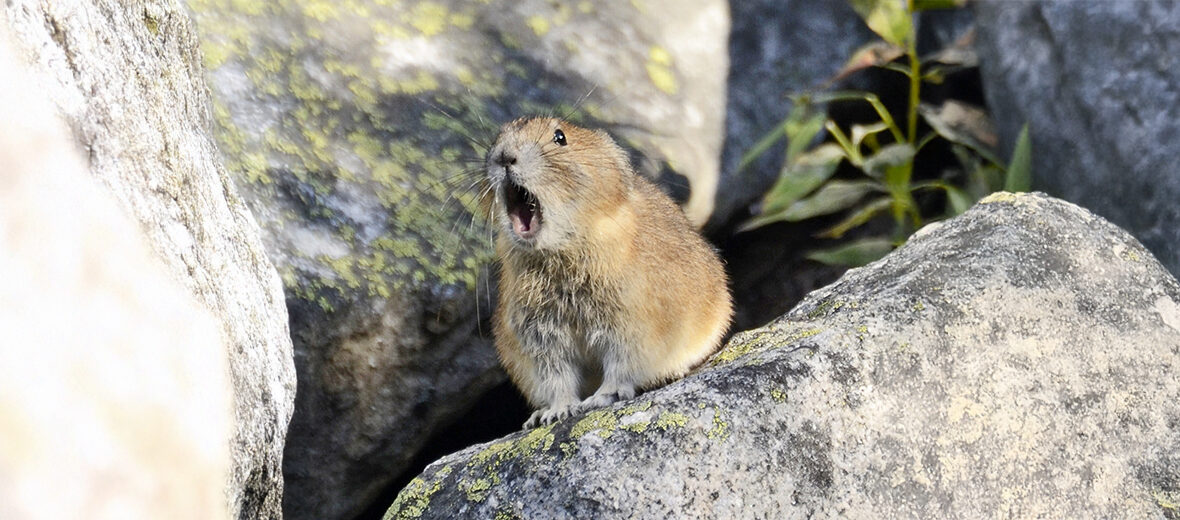
Scattered throughout western Canada and the United States the American pika, aka little Chief hare, is a species of lagomorph. They may look like rodents, but they are more closely related to rabbits, cottontails, and hares. These little critters prefer rocky, high-elevation habitats, specifically talus slopes and areas near alpine meadows. They are threatened by habitat loss and destruction at the hands of farming and ranching; hunting; trapping; and climate change, which causes habitat alteration and shifting as well as temperature extremes and droughts. However, they are abundant enough to be listed as Least Concern by the IUCN. Their numbers are decreasing though.
First the Stats…
Scientific name: Ochotona princeps
Weight: Up to 6 ounces
Length: Up to 8.5 inches
Lifespan: Up to 7 years
Now on to the Facts!
1.) These pikas are diurnal (active during the day).
2.) Bobcats, coyotes, eagles, foxes, hawks, mountain lions, and weasels all prey on these pikas.
3.) Males are called bucks and females are called does.
4.) While they don’t dig their own burrows, they do dig to enlarge their hides.
5.) Fireweed, various grasses, sedges, and thistles are all on the menu.
But wait, there’s more on the American pika!
6.) Even though they tend to get their daily water requirement from the foods they eat they will also drink standing water, if available.
7.) The 2 methods of eating are consuming food on the spot or creating hay stacks of cached food at the entrance of their hide, which is called haying.
Did you know…?
When haying, these pikas can make up to 13 trips per hour to collect and cache food.
8.) When haying, American pikas harvest plants in an intentional order, corresponding to their seasonal phenology (relations between climate and periodic biological phenomena – such as a plant’s flowering time). They seem to assess the nutritional value of various foods and harvest accordingly. Pikas choose plants that have the higher caloric, lipid, protein, and water content.
9.) Like other lagomorphs, pikas are cecotropes (eat their own feces that is specially produced and expelled due to its high nutritional value).
10.) Being territorial, these critters will aggressively defend an area of up to 7,630 square feet against other pikas of the same sex.
But wait, there’s still more on the American pika!
11.) All pikas are reflex ovulators (ovulation only occurs after copulation) and they are also seasonally polyestrous (females have multiple estrous cycles).
12.) Females undergo up to a 30 day gestation (pregnancy) that yields up to 3 kits.
Did you know…?
A study in North Cascades National Park in Washington found that a single winter of little to no snow caused dramatic reductions in pika numbers, demonstrating how snowpack provides a necessary insulation against cold winter temperatures.
13.) Kits are born altricial (blind, slightly haired, and helpless) and are weaned in up to 4 weeks.
14.) American pikas were first described in the scientific literature of John Richardson in Fauna Boreali-Americana in 1828.
15.) The Pikas in Peril Project, funded through the National Park Service Climate Change Response Program, began data collection in May 2010. A sizable team of researchers and National Park Service staff, from 3 universities and 8 national parks, worked in tandem to address questions regarding the vulnerability of the American pika to future climate change scenarios projected for the western United States. The project finished in 2016.
Now a Short American Pika Video!
Be sure to share & comment below! Also, check out the Critter Science YouTube channel. Videos added regularly!
Want to suggest a critter for me to write about? Let me know here.
Some source material acquired from: Wikipedia & IUCN
Photo credit: V. J. Anderson




